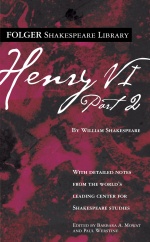Henry VI, Part 2
Henry VI, Part 2, one of William Shakespeare's plays, presents a kind of story that was popular before Shakespeare began writing, tracing the fall of powerful individuals to their untimely deaths. The first to go is the Duke of Gloucester, Lord Protector of England and the most powerful man in the kingdom, who is murdered after his wife goes into exile.
Next to meet a bad end is the Duke of Suffolk, the queen's lover, who rules England through her. After Suffolk conspires with the cardinal of Winchester to kill Gloucester, he is banished and assassinated. The cardinal dies raving of his own guilt.
Ultimately, the king's weakness lies behind these events. Preferring spiritual contemplation, he has left others to contend for power. Now his liberty is at risk as Jack Cade, and then the Duke of York, rise against him. The play leaves us in suspense about Henry's fate by ending with the start of the Wars of the Roses—a conflict setting the white rose of the Duke of York against the red rose of King Henry, of the House of Lancaster.
Scholars suggest that Shakespeare wrote this play in 1590-91. A version was published as a quarto in 1594. Sources include Edward Hall's Union of the Two Noble and Illustre Families of Lancaster and York, Robert Fabyan's Chronicle, and other works.[1]
Productions at the Folger
Early editions
First Folio
- LUNA: First Folio: l2v - o3v
- Hamnet: STC 22273 Fo. 1 no. 68
Second Folio
- LUNA: Second Folio: n4v - p5v
- Hamnet: STC 22273 Fo. 2 no. 07
Third Quarto
- LUNA: Third Quarto
- Hamnet: STC 26101 Copy 3
Modern editions
Henry VI, Part 2 can be read online with Folger Digital Texts and purchased from Simon and Schuster.
Hamnet link to Folger Edition: PR2753 .M6 2003 copy 2 v.13
In popular culture
Translations
Performance materials
Other media
Image Group
Explore the curated image group for Henry VI, Part 2 in the Folger digital image collection.
Notes
- ↑ Adapted from the Folger Library Shakespeare edition, edited by Barbara A. Mowat and Paul Werstine. © 2008 Folger Shakespeare Library.



